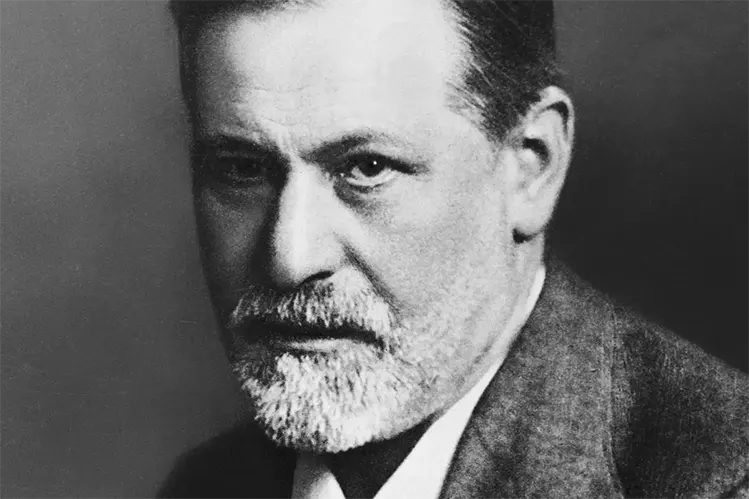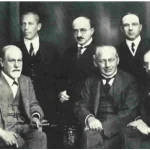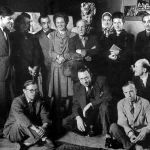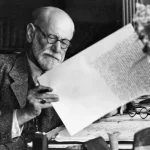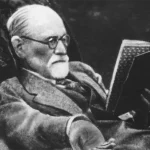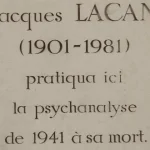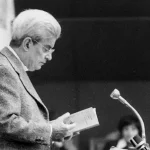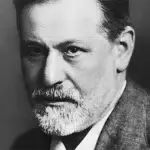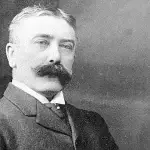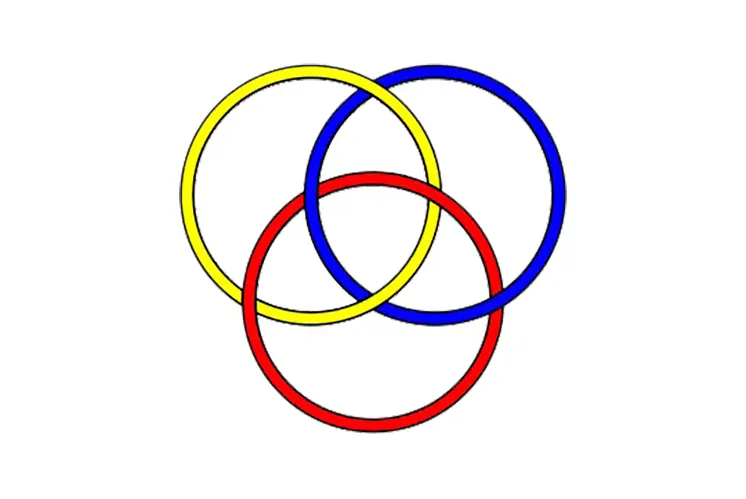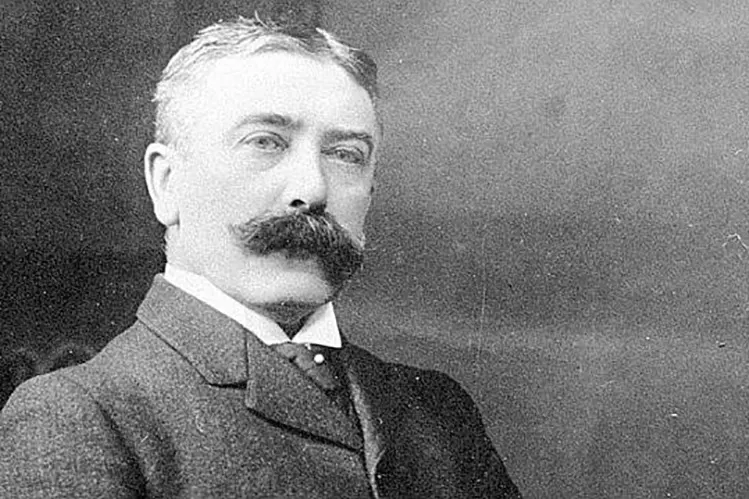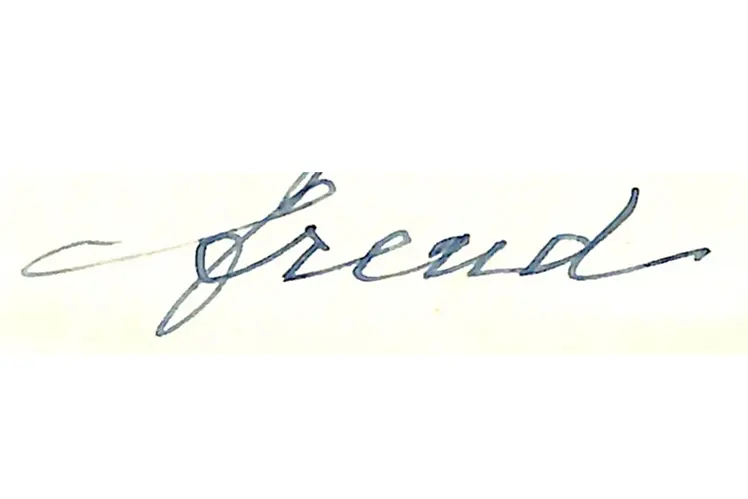Aggression: for Freud, instinctive and innate. See Thanatos.
Agoraphobia: the ego’s method of self-limitation for avoiding the anxiety of acting out a sexual desire. Don’t leave the house without id.
Anaclitic: the kind of love that is directed toward an object, usually a parent. Contrast narcissistic.
Anal Character: one fixed at the anal level of psychosexual development, when the libido charges the anus with energy. People stuck at this early stage are regarded as parsimonious, obstinate, hoarding, and perfectionistic.
Analysis, the purpose of: to give the ego more control over the repressed id impulses. “Where there is id, there shall ego be.”
Analysis, the fundamental rule of: to say whatever what comes into one’s mind without censoring any of it. See free association.
Anti-Cathexis: a process of internal frustration that, evolved from experiences of external frustration, sets up and maintains a repression. It involves the withdrawal of libido from whatever is being repressed. Anti-cathexes also oppose the impulsive cathexes otherwise made by the id toward objects. See cathexis.
Anxiety, three types: reality (anxiety about the external world), normal or moral (anxiety about the superego’s (originally, the parents’) punishing shoulds and oughts), and neurotic (anxiety that a repressed sexual wish might surface). Anxiety is felt only by the ego and might have hereditary components. In his later work Freud referred to anxiety as a danger signal.
Archaic Heritage: phylogenetic remnants of the species’ mental functioning such as inherited dispositions, ideational contents, and memory traces from former generations. Unlike Jung, who coined the term “collective unconscious” (now often referred to as the “objective psyche”), Freud gave these inherited remnants little more than a mention; for him, the wishes, feelings, and aggressions derived from the present life held much more importance. However, he does discuss them as a link between group and individual psychology, a repository of the ancestral memory of the murdered primal father (see Primal Horde), and the reason why Oedipal and castration fears are often excessive in comparison to actual family-of-origin dynamics.
Association: the link between one mental content and another. To Freudian thought itself, for example, some people associate trains going into tunnels.
Autoerotism: Havelock Ellis’s term for the baby’s habit of pleasing itself sensually with its own body. In normal development it gives way to an erotism directed at love partners.
Bind: the process by which the secondary process manages or traps free libido. Thinking instead of fornicating, for instance. (Obviously, binding has disadvantages as well as advantages….)
Bisexuality: what we all have going psychically. For Freud, this meant that everyone is part passive (= female) and part active (= male), although later in his career he began to question those problematic traditional equations. The idea of inherent bisexuality came to him from his friend Wilhelm Fliess.
Cathartic Method: the name Freud and Joseph Breuer gave to their method of allowing patients to get relief by talking out their previously repressed emotions. Freud quickly realized that this relief was only temporary and did not produce lasting personality changes. Breuer ran away when a patient fell in love with him. Freud lit a cigar.
Castration: what boys fear from their fathers, a fear reinforced by the boy’s eventual knowledge that women have no penis and are therefore “castrated.” Castration anxiety forces the boy to repress his sexual desire for his mother and identify with his father, a formal rival for mother’s love, and grow up to smoke a lot of cigars by way of defensive compensation. See Oedipal Complex.
Castration fear (boys) and penis envy (girl) together make up the “castration complex.” Because women feel less intense castration anxiety (being “castrated” already), they develop less of a superego.
Cathexis: the investment of libido in objects. An example would be Freud’s enormous cathexis of interest around sexuality. Cathexes correspond to ideas, whereas affects are discharge products.
Compulsion Neurosis: a mental illness whose symptoms are either prohibitions and atonements (e.g., washing one’s hands over and over) or symbolic substitute gratifications. As always for Freud, the problem’s core is repressed sexual wishes–in this case the desire to masturbate. We now call this Obsessive-Compulsive Disorder.
Condensation: the dream’s tendency to combine several themes into one dream symbol. In this way the symbol can stand for several different thoughts, feelings, wishes, ideas.
Conscience: one of two sectors that comprise the superego. Basically, an internalized critical parent. The conscience turns our innate destructiveness back upon ourselves and thereby safeguards the cohesion of society. At the same time, renunciations of drive strengthen the conscience. Unlike the ego ideal’s internalized standards, those of the conscience deal mainly with what is “bad.” Ultimately, it is fear of castration.
A severe conscience comes about by 1. frustration of a drive, which releases aggression needed to build the conscience, and 2. being loved, which directs innate aggression back to the person who has it.
Conscious: a quality of the mental life of the ego. The ego uses consciousness to manage reality, which includes allowing pleasurable id gratifications that don’t collide with everyday demands or provoke the “thou shalt not”s of the superego.
Counter-transference: the therapist’s transference projections–in other words, enactment of old conflicts from the family of origin–onto the patient. Example: when “Anna O” (Bertha Pappenheim) fell in love with Freud’s partner Josef Breuer, he fled because the situation aroused intolerable emotions in him. (For an example of Freud’s countertransference, see his Dora paper.) The meaning of countertransference has broadened since Freud’s time to include all the therapist’s reactions toward the patient.
Counter-wish: in a dream, an element that appears to contradict a wish but actually fulfills it. The frustration dreams of a masochist, for instance, who gets off on being frustrated.
Culture, two purposes of: to protect us against nature, and to regulate our affairs with each other. To adapt to life in a culture, one must repress one’s drives (repress one’s sexuality and aggression, displacing the second onto suitable targets outside the culture and sublimating the first into other achievements). “Man is a savage beast,” and to repeat a quotation from Plautus which Freud liked, “Homo homini lupus” (“Man is a wolf to man”–written, presumably, by a wolf). So Eros and Ananke (Love and Necessity) are the parents of civilization, and social restrictions on sexuality are unavoidable.
Were it not for our need to live with one another, we could allow our drives free play and not be neurotic.
Death Instinct: should actually be translated “death drive.” A fundamental tendency for life to seek the perfect equilibrium of entropic non-activity–in other words, dissolution. “The goal of life is death.” See Thanatos.
Defense Mechanism: a maneuver employed by the ego to protect itself against anxiety raised by intolerable impulses. All involve some degree of repression of the unacceptable impulse into unconsciousness. Examples include denial, idealization, splitting (e.g., both loving and hating someone but keeping both emotions entirely separate), reaction formation (e.g., becoming a Scoutmaster to prove to yourself that you don’t hate children), undoing (basically, trying to repair an action for which you feel guilty), and an American favorite, intellectualization (“You ask me how I feel, and it seems to me that the relevancy of the issue has more to do with my sublimated urge to…” blah). Freud’s daughter Anna discovered some more, perhaps because being analyzed by your father makes them so necessary to have handy.
.
Déjà Raconté: the patient’s illusion of already having said or done something in the therapist’s presence when this did not really occur. The patient indeed had the impulse, but didn’t act on it. Often happens at payment time.
Denial: a defense mechanism in which what is true is intellectually denied.
Depression: caused by repressed anger at a lost object (an important person who has become unavailable, left, or died) directed toward oneself.
Disavowal: a splitting of an ego confronted by some distressing demand from the outer world. Contrast this with repression, where the demand comes from within.
Displacement: the dream’s tricky transfer of high-impact emotionality onto unimportant material and an emotional cooling to hot material. This and condensation are the most important doers of the distortive dreamwork that censors the true wishes underneath the dream. Displacement also refers to the tendency of libido to invest itself in objects other than the original object of its aim. It is therefore a key factor in personality development.
Dream: an invariably egotistical internal state made external. A brief nightly psychosis. A regression prompted by an infantile wish seeking fulfillment. “The royal road to the unconscious” because dream symbols (discovered by Scherner) can be interpreted in a way that enlightens the therapist about what’s going on in the patient’s unconscious. Dreams are compromises in that they express a conflict about a wish: pulling together material left over from the previous day, they fulfill the wish (or several wishes) symbolically but keep that unconscious and the dreamer asleep through the use of a repressive censor who rewrites the latent emotional material into manifest imagery difficult to understand. Dreams are invariably the products of conflict and can be prompted by either ego or id.
Dream-day: the day before the dream, and from which it gathers its material.
Dream Series: a serious of similar dreams; it is to be interpreted as a whole.
Dreamwork: the mental activity that translates the latent wish-seeking unconscious material into the manifest imagery that disguises it. Dreamwork is NOT the work one does on a dream. Includes condensation, displacement of affect, identification, composition, inversion, and secondary elaboration. (Since Freud’s time the dreamwork seems to be falling down on the job. Some of these cigar-in-mouth and piston-in-shaft and tearing-your-boss’s-head-off dreams don’t seem to be very well disguised.)
Drive: Trieb in German; this word is almost always translated “instinct,” incorrectly. By drive Freud meant the bodily demands upon mental life. Freud believed in good materialist fashion that mind arose from drive, ego from id. A drive has a source (bodily needs that arise from the erogenous zones), an impetus, an internal aim (temporary removal of the bodily need), an external aim (the steps taken to reach the final goal of the internal aim), and an object. Drives give rise to the libido-energy that drives all psychological activity. We never experience the drive itself, just its representation or idea in the mind.
A drives might undergo the following “vicissitudes”: reversal into its opposite (via either changing from active to passive or reversing its content–love into hate); turning around upon the subject; repression; sublimation; and anxiety. The operation of the first two vicissitudes depends on the narcissistic organization of the ego. All these vicissitudes amount to the drive subjugated to the three great polarities that regulate psychic life: activity/passivity (biological), ego/external world (real), pleasure/pain (economic).
Drive Derivative: associations, symptoms, anxiety, and other kinds of material derived from a repressed drive.
Ego (Ich): the “I,” a rational, organized agency that distills gradually out of a passionate id that rubs up against reality. Emerging from an undifferentiated mass of sensations (chiefly those emanating from the surface of the body), formed by identifications and abandoned id cathexes, and strengthened by speech, which links auditory and visual memory traces with the conscious life, the ego strives to harmonize inner and outer, drives (which it keeps at bay mainly via repression, sublimation and anticathexes), inhibition, and reality. Unlike Jung’s conception of ego, it is not entirely conscious, though it is the bearer of consciousness. Topographically, it extends down into the id.
Ego Cathexes: investments of libido into ego activities like ideas that the ego knows represent objects. You think about what you want instead of blindly leaping for it because of the energy investment remaining with your thoughts.
Ego Ideal: the sector of the superego that consists of internalized standards of what is “good.” Shoulds and oughts for Freud represent the higher human nature, whereas for most of us they represent the highest accomplishment of Sunday school.
Ego-Instincts: an early concept denoting the ego’s self-preservative drives (as opposed to the other-directed sexual drives). The concept came about from the notion of conflicts between ego and sexuality. The duality of Eros and the death drive replaced this old duality.
Electra Complex: the feminine equivalent of the male Oedipal Complex. A chief difference is that the girl isn’t required to shift her identification from her mother to her father. Also, because of penis envy, she wants to have a baby with her father; this desire later gets acted out by her choice of a fatherly man to have a baby with. The term “Electra Complex” may have been proposed by Jung.
Endopsychic Conflict: the opposition of a cathexis by an anti-cathexis (or: being torn between a desire to satisfy a wish and a fear of doing so). Two types: id-ego conflicts and superego-ego conflicts.
Erogenous (or Erotogenic) Zones: those areas of the body most liable to sexual stimulation–namely, the mouth, anus, and penis, although Freud regarded the entire body as an erogenous zone.
Eros: one of the two basic sources of all the drives. Eros, whose name comes from the Greek god of love, is the principle of life; it binds together and is most clearly seen in love. Its drives tend to be more plastic and displaceable than those of its opponent, Thanatos, the death drive. Freud saw psychic life as an interplay of these two ever-interpenetrating forces, Life and Death.
Erotogenicity: the activity of a bodily area that conveys sexually exciting stimuli to the mind.
Family Romance: the tendency to defensively glamorize one’s family of origin in order to avoid hating them.
Fausse Reconnaisance: a false memory of having told the analyst something previously. Prompted by a fantasy of wanting to tell something but not following through, perhaps due to resistance.
Fetishism: based on the (usually) male fetishist wanting to avoid his own castration fears by insisting that women have a penis–namely, the fetish. Hm!
Fixation: when something libidinal is arrested in its development even though the rest of the personality keeps on growing up.
Force: necessary to the preservation of a society because people have innate aggressive, incestuous, and cannibalistic tendencies and won’t work unless coerced. Freud regarded the conflict between person and culture to be, at bottom, unresolvable; at best, society’s dictates and codes become internalized into a superego that acts as an internal agent of society.
Free Association: you are talking about a particular image in a dream, or an event that happened during the day that stuck with you, and your analyst asks: “What does that bring to mind?” Your candid response consists of associations, “free” because freely experienced and shared. The more superficial and random the associations, the more one should suspect that the censor is at work.
A source of this technique begins with “Emmy von N.” (Barronness Fanny Moser), a wealthy widow patient who got tired of Freud’s questions and said he should stop asking her where this or that came from, but let her tell what she had to say. She was also the patient who convinced Freud of the uselessness of hypnosis for deep treatment.
Freudian Slip: a mistake, usually of speech, made due to the collision of conscious and unconscious conflicts. An example made famous by Freud: the reluctant official who opens a meeting by accidentally declaring it closed, thereby revealing his true wish.
God: an idealized image of a nurturing (and primal) father created to reconcile us to Fate’s cruelty, compensate us for the injustices of life, lend social moralities a divine origin, and personify and appease the uncontrollable forces of nature. He is a condensation of prior gods. His Judeo-Christian characteristics unconsciously permeate Freudian thought.
Group Psychology: Freud distrusted groups, particularly large ones, almost as much as Jung did. Two key components of mass process: regressive identification with a powerful leader or idea, and replacement of one’s ego ideal with that leader or idea.
Guilt: from either a dread of an external authority or dread of the demands and punishments of the superego, an internalizedauthority. It is through drive-repressing guilt and the resulting sublimations that civilization arose. Guilt also has a primeval source: the murder of the primal father (see Primal Horde).
Hypnosis: Freud spent a year in Paris learning it from Charcot. Impressed at first, he later abandoned it; as with the cathartic method, it did not produce long-term results.
I
d (Es): the permanently unconscious motivational cauldron of the mind. From the id (the “it”) originate all the drives that impel psychic life. A “residue of countless egos” inherited from prior generations, the id is the amoral beast within us that seeks only its own gratification through tension discharge. It is powered by the bodily instincts and is wholly irrational. Analogous to the job of the imperialist and the industrialist, the job of the ego is to dominate it. (The term id comes from Groddeck, who got it from Nietzsche.)
.
Imago: see Object.
Instinct: see drive. Freud discussed instincts, which are relatively unchangeable, primarily in connection with animal life, not human life.
Introjection: Ferenczi’s term for the psychological action by which a person is internalized and made a part of one’s own psyche.
Inversion: 1. Homosexuality, the cause of which, for Freud, was in the boy’s failure to disidentify with Mom and identify with Dad and in the girl’s identification with Dad rather than Mom. 2. The dream’s transformation of one thing into its opposite in order to disguise it.
Latent Content: the true thoughts below the manifest imagery of the dream. Psychoanalysis seeks to translate the “disguised” manifest content into the true latent, and therefore repressed, wishes of the dreamer.
Libido: the psychosexual energy originating in the id. Libido is the electric current of the mechanism of personality. It powers all psychological operations, invests desires, and undergoes ready displacement. It is the basic fuel of the self. Because it is of a relatively fixed quantity, like gasoline in a tank, it obeys laws of psychical “economy” in that a surplus in one system means a loss somewhere else. It can be either free or bound (Breuer’s term).
Melancholia: see Depression.
Manifest Content: what we usually think of as the dream itself, and what Freudians see as surface, a disguise of the true latent dream material.
Masochism: caused by an alloy of erotism and a sadistic superego. It fills the ego with a desire to atone by punishing itself. An original or primary masochism develops into a 1. feminine, 2. erotogenic, or 3. moral masochism via a turning of unresolved sadism against oneself (secondary masochism). Too much internalized death drive and you get masochism; when directed outward, sadism.
Melancholia: we now call this depression. For Freud it shares with mourning a gradual withdrawing of libido from an object known to be lost or dead–but it is different in that the unconscious hatred felt toward the object with which the ego narcissistically identifies is turned against the ego. One then achieves revenge against the lost object by getting depressed.
Metapsychological: taken together, those aspects of Freud’s theorizing that are economical ( the hydraulics of unpleasure-avoidance through pleasure), dynamic (libido movements among id, ego, and superego), and topographic (psyche as structured into conscious, preconscious, and unconscious layers). Metapsychology also takes clinical observations beyond the consulting room and applies them to everyone, with varying results. Although psychoanalysis began as a treatment method, Freud’s real interest was caught by those theorizings that applied it to human psychology in general. Referring to two recent books, Freud wrote this to his friend Oskar Pfister:
“I do not know whether you have guessed the hidden link between my ‘Lay Analysis’ and ‘Illusion.’ In the former I want to protect analysis from physicians, and in the latter from priests. I want to entrust it to a profession that doesn’t yet exist, a profession of secular ministers of souls, who don’t have to be physicians and must not be priests.”
Moses: based on work by Sellin, Frazier, and others, Freud speculated two Moses: an Egyptian nobleman who lived near the time of the Egyptian pharaoh Akhenaton, the founder of the first monotheism, and gave the Hebrews a modified version of that religion and was killed by them as a result; and a Midianite who resurrected this religion, modified it still further, and coupled it with the Egyptian rite of circumcision, thereby setting the Hebrews apart as a chosen people.
Narcissism: the investment of libido into oneself. The libidinal equivalent of egotism. Freud regarded it as a perversion until 1914, when in “On Narcissism” he wrote that normal development means transferring more and more attention and interest into other people and thereby decreasing one’s original or primary state of narcissism. Primary narcissism is the self-involvement all infants start out with; secondary narcissism is a turning of libido away from objects back to the ego, as with what we now call the narcissistic personality.
Neurosis: a conflict between ego and id that produces symptoms of psychological discomfort. This physiologic-sounding term has been changed to “anxiety disorder.” That’s regrettable, since many neuroses don’t involve conscious anxiety.
Neurosis results because we live in cultures that require for their cohesion a renunciation of our drives, a repression that makes us a bit irrational.
Nirvana Principle: Barbara Low’s term for the psychological equivalent of homeostasis, the push for the least amount of tension. Different from the pleasure principle in that 1. pleasure sometimes increases with tension, and 2. the Nirvana Principle is primarily under the sway of the death drive, whereas the pleasure principle is powered by Eros.
Object: a mental representation of a person. Also called an imago.
Oedipal Complex: the boy’s tendency, around the age of five, to experience his freshly awakened sexual strivings toward his mother while wanting to replace his father in her affections. Mostly unconscious. When successfully resolved, these feelings are fully repressed, and the boy, afraid of castration, learns to identify with his father. As a result of all this, he internalizes his parents and acquires a superego whose ego ideal replaces some of his early narcissism. The feminine equivalent has been named the Electra Complex, but for Freud, women have inferior superego development and therefore an inferior conscience because they never have to disidentify with mother as boys do.
Freud saw an unresolved Oedipal Complex as the cause of every significant neurosis. The name comes from King Oedipus, who killed his father, married his mother unknowingly, and put his own eyes out (which Freud interprets as symbolic castration) when he discovered the truth of his origins. In a late innovation, Freud was prompted by the work of female analysts like Helene Deutsch to emphasize the initial pre-Oedipal strength of the mother-daughter bond.
Oral Character: forever wanting to suck, to consume, to take in, endlessly hungry and needy. See Psychosexual Development.
Orgasm: in women, vaginal rather than clitoral, the latter being a symptom of immaturity.
Paranoia: a defense against unconscious homosexuality. (Later analysts see paranoia as a projection of the paranoid person’s aggressive impulses.)
Parapraxis: Freud never used this word. He wrote of the Fehlleistung, the faulty achievement, when we mean to do one thing and do another. Slips of the tongue are one example.
Penis Envy: a subset of the castration complex, it involves the supposed envy of “castrated” women of the male member, which they later seek to possess via pregnancy and childbirth. Freud believed that women never forgive their mothers for leaving them “castrated” and without a penis. Certainly Freud’s little sister was left with something to think about after her mother left her without a piano. Freud, the family tyrant, disliked music, and his wish-fulfilments were law.
Perversion: a sexual drive component that fails to come under the dominance of the genital area and its reproductive needs and instead focuses on some non-reproductive object or aim.
Phobias: in general, due to repressed sexual wishes aroused unconsciously when the phobic object resembles the yearned-for object of gratification. The phobia of animals = dread of the father.
Pleasure Principle (long version: the Pleasure-Pain Principle): our most fundamental striving is toward pleasure and away from pain. Pleasure is what we feel when some kind of tension is relieved. Two types: forepleasure (infantile stimulation) and endpleasure (mature satisfaction). See Reality Principle.
Polymorphous Perversity: the young child’s tendency to get sexual gratification from damn near anything, regardless of its gender or nature. As a result of psychosexual development, this tendency is usually replaced by “normal” heterosexuality.
Preconscious: that which upon reflection could become conscious voluntarily. For instance, remembering your wife’s name when you weren’t thinking about her. The ego’s inner layer. That which is unconscious is repressed and therefore held out of awareness.
Predicate Thinking: the id’s tendency to treat dissimilar objects as identical. See Primary Process.
Primal Horde: the original primitive grouping of humanity headed by a father-authority who forbad incestuous actings-out among younger men, who, to gain their sexual freedom, eventually overpowered and eating him and thereby discovered the powers and benefits of community. In a way, similar to what befell the Wednesday Psychological Society.
Primal Fantasies: unconscious fantasies stemming from having perceived one’s parents having sex.
Primary Process: produces a memory image of an object needed for gratification in order to reduce the frustration of not having been gratified yet. This develops as the id encounters frustrations of its desires, and it works because for the id, an image is the same as an object (“an identity of perception”). Primary process is preverbal and dreamlike, not rational as with the ego. It’s called “primary” because it comes first in human development: for Freud if not for later theorists, the baby is, so to speak, all id.
Projection: experiencing someone emotionally in the present in terms of someone in your past.
Psychoanalysis: the theories and therapies that have evolved from Freud’s work with his patients. Examples include neoanalysis, object relations, ego psychology, self psychology, and intersubjectivity.
Psychodynamic: the perspective that personality is constituted by interacting and sometimes conflicting psychological forces.
Psychosexual Development: Freud’s developmental notions, many inspired by Karl Abraham’s original work, centered around the idea that libido invests certain bodily zones with energy as the child grows older. The order of stages is: oral (birth to eight months), anal (eight months to two years), phallic (two years to six), latency (six to twelve), genital (puberty to adult). As one masters the stages, one’s ability to exert ego control over one’s drives grows.
Family conflict can fixate a person on any of these stages and thereby produce a lasting effect on character: the greedy, ever-empty, grasping oral type; the fanatically orderly and controlling anal type; the thrusting, ambitious phallic type; the quiescent latent type (this one isn’t seen as so pathological)–and the mature outcome of a successful upbringing OR analysis, the genital type, devoted to love and work, but not necessarily in that order.
Psychosis: whereas a neurosis is a conflict between ego and id, psychosis is a conflict between ego and reality.
Purified Pleasure-Ego: that sector of the ego that rids itself of badness by projecting it onto external objects.
Reality Principle: the ego’s sense of realistic and rational adaptive expectations. This principle evolves from and governs the heedless hedonism of the Pleasure Principle, at least in people who aren’t wealthy.
Reality-Testing: the knack of distinguishing between inner and outer, fantasy and externality.
Regression: a return, temporary or chronic, to an earlier level of psychological development. (An example would be the second Bush administration.)
Religion: a childlike yearning for an all-powerful Parent to take away feelings of helplessness that arise from confronting the forces of nature. A collective neurosis. An illusion (not necessarily an error) arising from childish wishes, religion spares many a believer an individual neurosis by reducing him to “psychical infantilism.” The first religion was a form of totemism.
Repetition Compulsion: the urge to do the same thing over and over, especially in terms of relationship patterns (e.g., always winding up with the same kind of partner). Rather than seeing it as unlearned lessons reconstellated in the present, Freud linked this to the death drive’s push toward a conservative return to previous conditions.
Repression: the ego’s ridding itself of unacceptable desires and ideas by dumping them into unconsciousness. Three conditions lead to a return of the repressed into consciousness: when the counter-cathexis holding it down weaken; when the drives below it get stronger; or when recent events similar in theme to what’s repressed reawaken it; in all three cases the repressed shows up in the very method used for repression (e.g., an archeologist who represses his erotic nature falling in love with an alluring statue). “Primal repressions” are handed down from the painful experiences of prior generations (example: incest taboo) and keep certain contents of the id from ever becoming conscious. “Repression proper” (also called “after-expulsion”) has to do with the repression of associations and ideas related to whatever idea is chiefly being repressed. An aim of psychoanalysis is to turn repression into condemnation.
Scopophilia: the pathological enjoyment that comes with watching sexual activity. This is a mistranslation of Schaulust, “sexual pleasure in looking.”
Screen Memories: memory fragments that cover a child’s earliest and forgotten sexual fantasies.
Secondary Elaboration: the dreamer’s tendency to fill in gaps in the dream and explain its mysteries in order to understand it better. This usually leads to significant misunderstandings of the dream’s true latent content.
Secondary Process: the ego’s reality-testing and energy-binding capability. In other words, thinking and reasoning. See Primary Process.
Self-Analysis: Freud conducted a long analysis of himself during the time he formulated the first psychoanalytic concepts. He believed much could be learned by analyzing oneself, but that being analyzed by someone else was necessary due to the many resistances and blind spots that occur in the course of self-observation. Asked about the number of analytic pioneers who had not been analyzed, he replied that they definitely weren’t the better for it.
Sexuality: obtaining physical pleasure. A much wider notion than reproduction and one that extends over the entire lifespan. It was apparently Wilhelm Fleiss, an intelligent crank who became Freud’s closest friend, who got him thinking about childhood sexuality. See eros.
Sibling Rivalry: based in what Freud, who’d been a momma’s boy, saw as a result of childrens’ overriding egotism. See Projection.
Soul: James Strachey has almost everywhere translated Seele–soul–into “mind” in his Revised Edition of Freud’s works and its operations into the medical-sounding “mental apparatus.” For Freud, soul was the overarching reality of all psychic functioning, conscious and unconscious. It had no sense for him of something supernatural, but it was his preferred term when describing the psyche as a whole as well as its very essence. If archetypal psychologist James Hillman has placed soul on an imaginal basis, Freud was the first to bring it into the realm of psychological discussion.
Spirituality: the power of abstract thought. For this reason Freud saw the commandment against idolatry as an elevation of
culture: our object of central concern, God, has become invisible and therefore abstract. See Religion.
Sublimation: when a sexual drive is directed into a different aim, like daily work, creativity, piety, etc. It was Goethe who introduced this term into common German usage; Hegel took it up later, as did Freud.
Superego (Uber-Ich): formed out of but less conscious than the ego, an agency that safeguards society from uncontrolled acting out by giving the person an internalization of all environmental inhibitions, particularly those of the parents. Developed as a result of millennia of monotheistic moralizing the resolution of the Oedipal complex, it fills you with guilt when you deviate from your internal standards. It’s a kind of parent-within formed of reaction formations to unconscious sexual wishes; obeying it results in the secondary narcissism of pride, an expectation of being loved by a parent figure, and disobeying it creates guilt. One of the therapeutic tasks is to lower its demands, which emanate less from the parents than from the parents’ superego.
It is subdivided into the conscience and the ego ideal and reaches deep down into the id.
.
Symptom: a partial satisfaction of a repressed wish. Symptoms blend repressive mechanisms with symbolic satisfactions; for that reason Freud considered them compromise formations. Every symptom has some anxiety behind it.
Thanatos: the mythic name students of Freud gave to the death drive he postulated in 1920 in Beyond the Pleasure Principle. This drive represents the organic need to return to lifelessness and stasis, the ultimate calm of lifeless non-conflict. Freud traced all aggressive and destructive activity to this notion, which impressed him deeply after the outbreak of one world war and the death of his daughter Sophie. That portion of the drive which is turned outward benefits the organism, which would otherwise direct it against itself. However, Freud did concede that destructiveness also affords the ego satisfaction of its old narcissistic need for omnipotence.
Taboo: a sacred-feeling prohibition that applies to an entire group. Its true purpose is to keep incestuous wishes unconscious. The rituals surrounding the taboo are similar to those of obsessive-compulsive neurosis but are collective rather than personal.
Telepathy: Freud believed tentatively in the possibility of telepathy, linking it with the emergence of psychic material from the primary to the secondary process.
Topographical: Freud’s division of psyche into three layers: the preconscious, the conscious, and the unconscious.
Totem: a common ancestor of a clan. Symbolized most often by an animal, it symbolizes the clan’s guardian spirit or helper. Psychologically, the totem is a stand-in for the father.
Totemism: the earliest form of religion, intended to forbid incestuous desires felt by family members toward one another. Freud regarded it as the basis of all other social obligations and norms.
Transference: a type of projection in which early parental conflicts are reexperienced with the therapist, whose job is to interpret them back to the patient. Freud first saw transference as a hindrance because it distorted the relationship between patient and therapist; later, he argued that a positive transference onto the analyst could help the psychoanalysis progress. He distinguished three kinds: negative, erotic, and sensible.
Traumatic Neuroses: those caused by situations of unusually high stress. They are the sole possible exception to the rule of neuroses being caused by unresolved Oedipal conflicts.
Unconscious: that which is repressed out of awareness. Its core is instinct-representations consisting of wish-impulses. Also, see Id.
Undoing: a defense mechanism by which we try to undo something we feel shouldn’t have been done to begin with. (Example: doghouse flowers.)
Wit-work: the process by which a denied impulse (invariably hostile or obscene) is converted into a joke. Similar to dreamwork.
